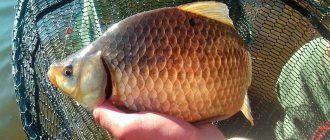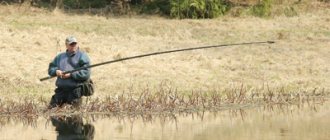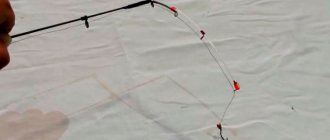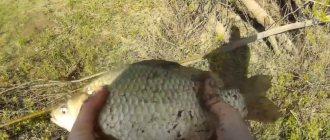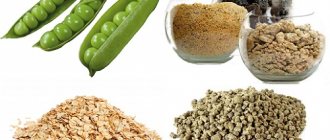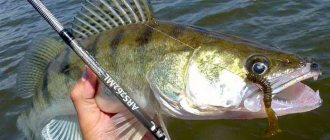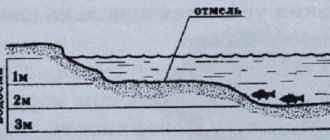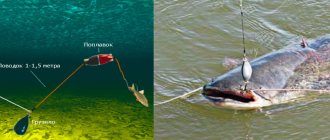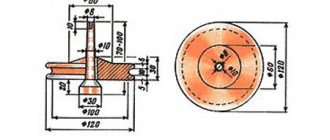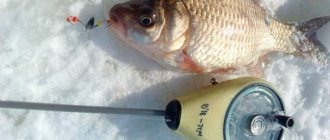In small reed creeks, you can start the open water season by catching crucian carp in the spring with a jig. In some places, especially in the south, you can catch silverfish with a side nod as soon as the ice melts from the reservoirs. With further warming, the bite will only intensify. Catching crucian carp in the spring with a nod allows you to search shallow water points completely overgrown with reeds that are inaccessible to a regular fishing rod, donkey or feeder.
In summer, this method also works among thickets and water lilies, from the shore, in a wade or from a boat. In this article, we will look at how to catch crucian carp with a side nod in open water, what gear and bait to use for this.
Spring crucian carp on a jig in open water
In the middle zone, crucian carp become active in the spring in April-May. In the south, you can catch it in the warm spring in March; the main period of activation begins in mid-April - when the air temperature during the day averages +15 degrees, and at night – about 8-10. The silver glutton is finally activated when the water temperature exceeds 12 degrees.
At this time, it finally moves from deep places to shallow overgrown pools, and migratory flocks rise up the tributaries. At a water temperature of + 16, spawning begins for crucian carp and continues until June. At the same time, the bite continues - individuals that have already spawned or have not yet started spawning are caught.
Fishing for crucian carp on the side nod in early spring is successful in those places where the crucian carp stays in overgrown shallow waters immediately after the ice melts. Usually these are coastal overgrown zones of reservoirs, rivers and shallow warm waters in the south of Russia and Ukraine.
Fishing for crucian carp in the spring with a jig in such creeks at this time is not yet as active as in warm water, but with a certain amount of endurance and constant searching, you can fish out a bast fish weighing one and a half kg from the reeds. Along with the silverfish, roach, rudd and sometimes carp are caught on the hook. In the middle zone, the active phase of crucian carp fishing begins closer to May, with the decline of the flood. More information about catching crucian carp in the spring:
With the final warming, the crucian bite develops into a pre-spawning feast. Nodding tackle allows you to fish the most inaccessible places - continuous thickets and small windows among them. Such points are the most promising places. Natural signals are the beginning of active growth of grass on the shore, reeds in the water, young leaves on the trees. Along with crucian carp in such bays, it is quite possible to catch carp with a jig.
Side nod to crucian carp in summer
With the onset of heat, the silvery fat fish moves deeper in clean reservoirs. But if there are thickets, the crucian carp will live in them throughout the entire season. Wherever you can crawl up or swim in a boat, go into wades, you can fish with a summer fishing rod on a side nod. The advantages of this method are obvious:
- With a fishing rod for crucian carp and jig in the summer, you can go around many points on foot or by boat. The search method works. The fisherman does not hatch fish using bait, but looks for cool spots on his own.
- In the reeds the fish are not so shy. You don’t have to go too thin with the equipment. On the contrary, in order to quickly pull fish out of the thickets, fairly thick fishing lines, 0.16-0.25 mm in diameter, are used.
- Sometimes the crucian carp does not take the stationary bait. And with a side nod and playing with a jig, it’s great for catching.
If the place is known or there is information that there is definitely crucian carp in these thickets, you can bait the window and wait, catching it one by one with a float or a side nod, selecting various baits, dips and bait methods. The choice of fishing tactics for crucian carp depends on the season. Catching crucian carp with a jig in the summer using a side nod can be as active as with a spinning rod.
In early spring, the search method works better, since the fish mostly stands still, and sometimes it is useless to sit on bait. In warm water, you can feed a point, especially if you know the composition that works for crucian carp for this reservoir, and fish in one place.
fishing line
The main requirements for a fishing line is the maximum load that it can withstand with a minimum thickness. Select a fishing line similar to the fishing line for winter fishing; a light jig should pull it under its weight. This greatly affects the entire tackle, directly on its sensitivity. It is worth choosing a thinner fishing line, so you can see the maximum number of bites.
Many fishermen use a rig with a leader. Catching crucian carp in the summer with a jig is no different from float fishing, and here the rein plays the same role; when hooked, it allows you to tear off one jig, and not the whole equipment, and is less noticeable to the fish.
Fluorocarbon fishing lines and the like are gaining popularity at high speeds. Like braids, they have a lot of power and are difficult to stretch. An excellent quality is invisibility in the water and the lack of memory in such fishing lines.
Side nod fishing tactics
For early spring crucian carp fishing with a jig, it is important to take into account points that directly affect performance.
- In early spring, in clear water, we use thin fishing lines, 0.14-0.16 mm. In very remote thickets it is difficult to fish with a thin line - there are continuous hooks. Therefore, we choose thinner reeds, windows, the border of clear water and thickets.
- Accordingly, on thin equipment we use small jigs, 0.5-2 grams, with small hooks, black or brown. Shiny and bright baits can now only scare the fish.
- For a light load, we also select a more flexible nod, otherwise we will not see careful bites from passive fish.
- The main tactical method is search. We walk along the shore, in wads, waders, the lower part of the OZK, or on a boat through shallow creeks with last year’s dead wood, along holes near the shore. At the same time, it is important not to make noise - not to splash the oars, not to stomp, not to stir up the water too much if we are wading. If we are wandering through the water, we walk carefully, 2-3 steps at a time. If you managed to catch fish in one of the places, you need to return to this point after 30-40 minutes and try again.
- Playing with a jig is slow, gentle tapping on the bottom, slow rises of 10 cm with pauses, or natural lowering of the bait.
- The baits are small, bloodworms, maggots, small worms. Bloodworms work best in early spring on the side nod. The mosquito has not yet flown out, and its larvae are the main food supply for fish in overgrown backwaters.
- Due to thin rigs and light jigs, it is difficult to work in the wind. Therefore, in early spring we choose quiet, sunny days for fishing. In summer, a slight breeze is, on the contrary, an ally. Firstly, the fish are calmer when there are ripples on the water, it is easier to approach them by boat and not frighten them. Secondly, in the summer jigs use larger, 3-7 grams, and more powerful nods. For such equipment, a light breeze is not a problem. In addition to crucian carp, in the spring in the thickets any fish can bite on the side nod - roach, rudd, and with warming - tench, carp, carp. Read more in an article about fishing with a side nod in the spring.
- For crucian carp in summer you need a larger jig. In warm water, the silverfish actively resists, and in the reeds it is not afraid of thicker fishing lines and large baits. You won’t be able to catch a large crucian carp from the reeds with a thin line in the summer. The power of the rig should allow you to rip out a fat silver fish that has sat on the hook immediately to the surface of the water and drag it towards you on top of the grass in the water.
In the summer, on an unfamiliar body of water, you can also start with a search, and feed already where there were bites. In water areas where there are a lot of fish and the terrain is approximately monotonous (hectares of monotonous thickets and even depth), we select a window or clearing and immediately feed them.
Naturally, in large bodies of water it is only possible to fish from a boat. You cannot approach the reed floodplains from the shore or by wading. Sometimes you need to prepare the window yourself by tearing through some of the grass to make casting easier.
The main task is to enable competition for food among crucian carp. Usually in the thickets, quite sparsely in the summer, there are a lot of fish, which gradually begin to gather at the point with bait. When there are a lot of fish in one place, the bait is thrown in a little at a time, and several crucian carp look at the abandoned bait at once. At the same time, they will try to grab the jig faster in order to get ahead of their brothers.
A moving jig in the reeds often works better than a float, since in addition to the smell, the crucian carp determines its location by the vibrations of the lateral line, and quickly comes out of the thickets to the bait. If everything is done correctly, you can catch more fish in an hour than in a whole day in early spring. The choice of tactics, searching or feeding at a point, depends on the characteristics of the reservoir. It’s worth trying both options in the summer and sticking with the one that works better. An article about side nod fishing.
Finding fish and fishing spots
We look for crucian carp in early spring in any available shallow overgrown places, even with depths of 50-70 cm.
- Shallow bays with reeds.
- The entire coastal zone of small and medium-sized rivers with the remains of last year’s reeds, pondweed, and cattails.
- Small oxbows and stakes, flooded thickets of willow and willow, flooded meadows.
- Overgrown shallow spits protruding into the main water area (you can wade along them quite far).
- In places where many fishermen fish in this way, walkways are laid on reed bays from the remains of lumber, old boards and pickets. You can fish directly from them, throwing a fishing rod into windows or clearings. A variety of bridges, dams, and piers are also suitable for fishing.
In summer, it is more convenient to use a side nod from a boat - a much larger number of promising places open up with depths of up to 2-3 meters. The best summer places for crucian carp and jigs are thickets of water lilies, egg capsules and water lilies. Under them there is usually just from 1.5 to 2.5 meters of water. In summer, heavier jigs can be used to fish not only in still water, but also in weak currents.
The boat provides an advantage if the feeding method does not work. From on board you can examine many more promising points. Catching crucian carp with a jig in the summer also works in the heat, in the middle of the day. In open areas near the shore it usually bites only in the morning and at sunset. However, crucian carp swim in water lilies in relative coolness, in the shade of leaves, and if you find a school, you can hit the fish at lunchtime, even in the heat.
Nodding fishing rod device
A telescopic rod of various lengths is used (it all depends on your choice and fishing location). A small reel is attached to it, on which a thin fishing line is wound. A nod is attached to the edge of the rod, which is painted in bright colors so that the crucian bite is more noticeable.
The nod itself is made of steel or synthetic material; it must have good springing properties. The jig is baited with various lures and baits depending on the fishing season. Now let's take a closer look at each element of the gear.
The choice of rod depends on whether you will be fishing from the shore or from a boat. If you have to fish from the shore, then it is advisable to use a rod 6-7 meters .
If you fish from a boat, then a more optimal rod is 4-5 meters.
Although in the spring, when the water is very clean and the fish can clearly see the boat, it may not come close. Then you will have to use a 6-7 meter rod. It is advisable for the rod to have rings, and install a small reel.
Since you will have to constantly hold the rod in your hands, choose it as light as possible.
The rod should be rigid, with rods that bend a lot making it more difficult to play with bait and generally control the process.
An important aspect is the choice of fishing line. It is best to use a fishing line with a thickness of 0.2mm, and a leash of 0.14. It is better to choose the color of the fishing line: marsh or brown. White or clear fishing line can be intimidating.
In this case, you need to take care of the jig. Shiny jigs are not suitable for catching crucian carp; they scare them away, but darkened ones attract them. The shape should be slightly elongated, 5-6mm long. Length including hook 1.2 cm, width no more than 3 mm.
You can experiment with the choice of jig yourself during the fishing process.
As an option, a medium-sized drop or ant is quite suitable.
The optimal length is considered to be 25 cm and, given the total weight of the jig, it should not bend by no more than 6 cm. The material from which the nod is made is not particularly important.
Fishing rod with a side nod for crucian carp
The fishing rod needs to be held in your hand at all times, so it should be light and comfortable. The nod is selected according to the weight of the jig - purchased or homemade. For coastal fishing, you can take regular carbon fiber telescopic rods up to 7 meters long. When choosing, you need to take the stick in your hand and shake it, try to reproduce the movements of the game with a jig.
You need to choose a rod that is light but stiff. Noodle sticks will not work - the tip will swing too much when playing. The best option is a lightweight carbon or composite telescope, rigid as a rapier, 5-6 meters long (from a boat - 4-5 meters). Both rods with rings and reel seats for fishing rods with reels, as well as fly rods with connectors for blind rigs, are suitable.
Some fishermen use long poles, up to 8 meters, without rings, and casting and retrieving are carried out by extending and reassembling the telescope arms. However, this method of fishing with a nod in open water is suitable for fishing in clean places, for example, for roach.
In 99% of cases, crucian carp needs to be caught in the thickets, so the jig needs to be lowered from above directly into the gap among the reeds. This is inconvenient to do with long rods over 6 meters. Read more about side nod rods.
Equipment
For summer jigs for crucian carp, you can use three types of equipment:
- Blind - on short fly rods. In this case, the depth at the fishing spot should be slightly less than the length of the rod. For example, a fishing rod is 4 meters long, and the length of line on it to the jig is 3 meters. This will allow you to fish at a depth of approximately 2 meters, keeping the rod tip 1 m above the surface of the water. It makes sense to assemble such a fishing rod for specific fishing conditions in one place.
- A more universal option is on a fishing rod for Bolognese tackle, with rings and a reel seat. The fishing line is wound onto a reel, which is attached to the fishing rod. At the same time, at the beginning of fishing, a working descent is set for each specific fishing spot, depending on the depth. Excess line is wound onto the reel. This option can also be done on a fly fishing rod without rings. In this case, a small, lightweight reel is attached to the upper half of the rod, sliding directly onto it through a hole in the middle. These first two options are “crutches”, in the absence of a normal light rod with rings.
Adjustable reel (top) - The most popular and universal rig for jigs for crucian carp in spring and summer is a fishing rod with a plastic inertial reel and guide rings. This allows you to use the search method of fishing, since you can quickly set the working descent depending on the depth at the fishing point. At the same time, the reel is a small, lightweight plastic, the most common and cheap. Fishing with a reel in the reeds is not carried out - the fish immediately pulls out at the angler. In addition, such a reel hardly weighs down the tackle.
- For fishing in early spring, we wind a monofilament line with a cross-section of about 14-0.16 mm on a reel, under light jigs. In regions where there are a lot of crucian carp, both large and not very shy, you can immediately reel in the summer version - 0.2-0.25, for heavy jigs and pulling fish out of the reeds.
- If you are fishing in water lilies, you can use thinner ones, 0.18-0.2 mm. The option of a thick 0.25 line with a 0.14 leash is not suitable for spring and light jigs.
- A light jig does not play well on a thick base. It’s better to rewind the monofilament - you don’t need a lot of it anyway, unless you have to fish for carp.
- To catch particularly large crucian carp or crucian carp, experienced jig fishers use a braided cord of 0.1-0.12 mm with a breaking load of 7-10 kg to quickly pull the fish out of the thickets. Working with a cord is more difficult - it is easier to tangle, however, with a certain skill, such tackle allows you to fish out larger fish from the grass. Soft water lilies are simply sawed or cut off by a thin cord if the carp gets entangled in them.
Nod
For fishing for crucian carp with a jig in open water, a more powerful nod is required than in winter, since the baits used are heavier. In addition, you need to think about its visibility from a distance corresponding to the length of the rod. When assembling the tackle, the nod is adjusted to the weight of the jig so that when loaded it bends by 5-7 centimeters.
The length of such a guard is 20-30 cm. You can place it on the fishing rod as usual, parallel to the fishing rod. However, a much more convenient option is a side gatehouse. For right-handers - on the left, for left-handers - on the right, it’s easier to see and it’s more convenient to observe the bite. The shorter the rod, the lighter the jigs and flexible nods can be used, provided there is no wind.
The side guard consists of a flexible form, a connector for attaching to the fishing rod, pass-through rings and a visual point for visibility (bead, flag, multi-colored heat-shrinkable tube). Sometimes such nods can be found in fishing stores.
Powerful lavsan guards for winter balancers are also suitable - an almost ready-made option, all that remains is to adapt them to the rod through an angular connector (in a homemade version - a piece of spring or wire attached at an angle of 90 degrees to the rod). When making a homemade connector, there is no need to make it heavy, otherwise parasitic vibrations of the fishing rod tip will be created when playing.
More often, fishermen make side guards with their own hands. To create a form, you can use various flexible materials:
- Plastic bottles;
- Construction tape;
- Clock spring;
- Lavsan;
- Plastic clamps;
- Lint from synthetic brooms;
- X-ray film.
Shop nod
It makes no difference how exactly the side guard is technically implemented - the main thing is that it produces correct play with the jig, passes the line without obstacles, and is securely attached to the rod. An article about making summer side nods.
Jig with float
Often, crucian carp fishermen use jigs in the equipment of conventional float rods. Some people just think it’s better this way. In other cases, it actually works better. Maybe the silverfish is interested in the sparkle of the jig, but the game is not needed, or simply the position at the bottom of the bait on the jig attracts him more than on the hook.
- The main advantage of this kind of fishing is for those who like not very active fishing, but rather calm contemplation of the float. In this case, you can sometimes weakly play with the bait, then lower it to the bottom again.
- Often it is after such provocations that a bite follows. There is no work with a nod in this equipment - so you can use longer rods, 7-8 meters.
- The bite is still detected using the float. Casting is the same as with a jig.
- The fishing rod is not cast - the rig is lowered carefully and precisely from above into the clearing the length of the fishing rod.
Article about spring fishing with a float rod for crucian carp
Baits for crucian carp
In the spring it is better to fish with bloodworms, and closer to summer, dung worms and maggots will be more successful bait. Then you can try fishing with corn, semolina, pearl barley, that is, with plant baits, which are preferable for fishing in the summer. Very effective baits are various larvae, worms and bugs, which can be collected from the bottom of burdock capsules and from reed stems. In the summer heat, it is on them that all the fish, and large ones at that, can be caught. Catching crucian carp with a side nod is also more successful than with a float rod.
Side nod
Fishing for crucian carp
January 2021. Situation on reservoirs
Side nod fishing technique
Some technical features and useful tips for catching crucian carp with a side nod from the shore and boat in open water:
- We experiment with the game - it is important to find the movements to which the crucian reacts. This usually involves relatively slow rocking 3-10 cm from the bottom, slow lowering or tapping to create turbidity.
- Crucian carp is not a perch, so we don’t constantly pull the jig. The game needs to be measured, slow, with pauses. Watch the videos embedded in the article. It is important to take pauses - crucian carp often take just during stops. We select the length of these pauses and alternate them with bait runs.
- After the first slow descent during casting, a bite may occur. Casting the rig and plunging the bait after it is already part of the game. We don’t throw the equipment, but slowly submerge it, accompanying us with the rod and watching the nod.
- Horizontal wiring and pulling along the bottom sometimes work in the spring. In summer, it is better to use only vertical play.
- Small crucian carp up to 300 grams like a more vigorous game, large ones - smooth and measured.
- In the heat of summer, fish can take fish not from the bottom, but at half-water or right under the water lilies. We check all horizons.
- Playing with a jig for crucian carp in the spring is even smoother and slower. After each rise or movement, we maintain long pauses at the bottom or let the bait hover 3-5 cm above it.
Lure
Bait for catching crucian carp in the spring with a side nod, as for other gear, at this time you need finely dispersed bait, with natural aromatics, without large food particles. If there are no small ruff, perch or roach in the reservoir, you can add food bloodworms to the mixture. Bait works well in the summer - to attract a flock and keep it in place.
In warm water, when there are a lot of large crucian carp, after spawning or in the summer, porridges made from millet, peas and pearl barley work well. In the summer we experiment with dips and flavors. In spring, you can’t feed a lot. We feed the fishing point a little.
When using search tactics, you can first walk or swim through the points and throw a walnut-sized lump of food into each one - perhaps this action will lure crucian carp standing nearby in the bushes into the window. In general, for nod fishing, the same recommendations for crucian carp bait apply as for other gear.
There is only one rule - in each specific reservoir, you need to select keys for crucian carp based on composition, aromatics and feeding tactics.
Article about spring bait for crucian carp:
https://rybafan.ru/rybalka/prikarmlivanie/prikormka-na-karasya-vesnoy
Choosing a fishing spot
They catch crucian carp with nodding tackle in snags up to 1.5 m deep, in “windows” of clean water among thickets of duckweed and aquatic vegetation. Often crucian carp fish well in reed thickets adjacent to thickets of other algae. When fishing in windows, the main thing is that the sun's rays do not fall into it: bright sunlight at shallow depths scares off crucian carp.
Jigs and attachments
The main element of bait is bait or bait. The jig essentially acts as a weighting agent. For roaches, the jig itself plays a much larger role. For crucian carp, the bait is more important. Many fishermen do not use jigs for this type of fishing - they place an ordinary lead shot above the hook.
In places where crucian carp is capricious, it is still better to use different jigs, depending on color and shape. You never know, maybe the crucian carp will be attracted to some specific bait, more from the point of view of the behavior of the bait under water when playing.
For crucian carp you don’t need the entire possible arsenal of jigs, as in winter. It is better to use the most ordinary balls, drops, boats, large ants, up to 8 grams, or special summer jigs for crucian carp - with a large hook.
Some use uralki, devils, goats, which are more suitable for baitless play, as well as additional pendants made of light jigs, plastic luminous ones (or simply a hook with bait, tied higher without a leash directly on the main line according to the drop-shot principle). There is no need for them to shine - dark, black tones are preferable.
In summer, crucian carp rarely take a reeler - it’s better to rely on the bait. Many fishermen make summer jigs for crucian carp with their own hands, soldering the hook into lead pellets or blanks with a crown. Read more about summer jigs.
A worm is often put on the hook. In cold spring, bloodworms or maggots work better in clear water. With warming - corn, pearl barley. Choosing the right bait for crucian carp in the spring is a wide field for experimentation on any gear. The following baits can be attached to the jig:
- Red dung worm, crawler or underleaf.
- Maggot.
- Larva of dragonfly, caddisfly.
- Small fry 2-3 cm.
- Salo.
- Pieces of dog or cat food.
- Salo.
- Udder.
- A narrow strip of dark foam rubber, like a tail, dipped in dip.
- Bloodworm.
- Cereals - corn, peas, pearl barley, wheat, star pasta or horns.
- Semolina, mastyrka, bread crumb with halva, honey, vegetable oil, dough.
- Beads, pieces of rubber, polystyrene foam, artificial bloodworms or maggots, cookies and ottomans.
The classic bait is a bunch of worm. However, in some reservoirs the tastes of crucian carp are specific. You need to experiment not only with baits and methods of planting them, but also with aromatics. As dips and attractants, the crucian fisher should always have anise and garlic with him. This may also work:
- Fennel, cinnamon, dill, flax, hemp, vanilla, coriander, honey.
- Any industrial fishing dips.
- Valerian;
- Star ointment;
- WD-40 lubricant;
- Kerosene;
- Vegetable oils – hemp, flaxseed, sunflower.
We work with dips extremely carefully so as not to stain our hands and the bait. We dip only the baits to highlight them on the bait spot. You can add a little weak aromatics to complementary foods and only after finding out and confirming with bites that the crucian carp is attracted to this specific smell - otherwise you can spoil the point and scare away the fish.
Subscribe to the channel:
YouTube channel RYBAFAN
We are VKontakte
Main advantages of side nod
Probably the main advantage of this non-standard and successful fishing is the ability to fish where a conventional float rod fails . Namely, in dense thickets of reeds and among the dense “burdock” of water lilies, where it is difficult to detect even a small window. You can’t throw a hook with bait and a float of a Bolognese or fly fishing rod here, much less a feeder feeder. A light jig with a bloodworm, worm or maggot will slip freely among the reeds and egg capsules. And a nod moving to the side from the tip of the rod tip will sensitively indicate a bite.

